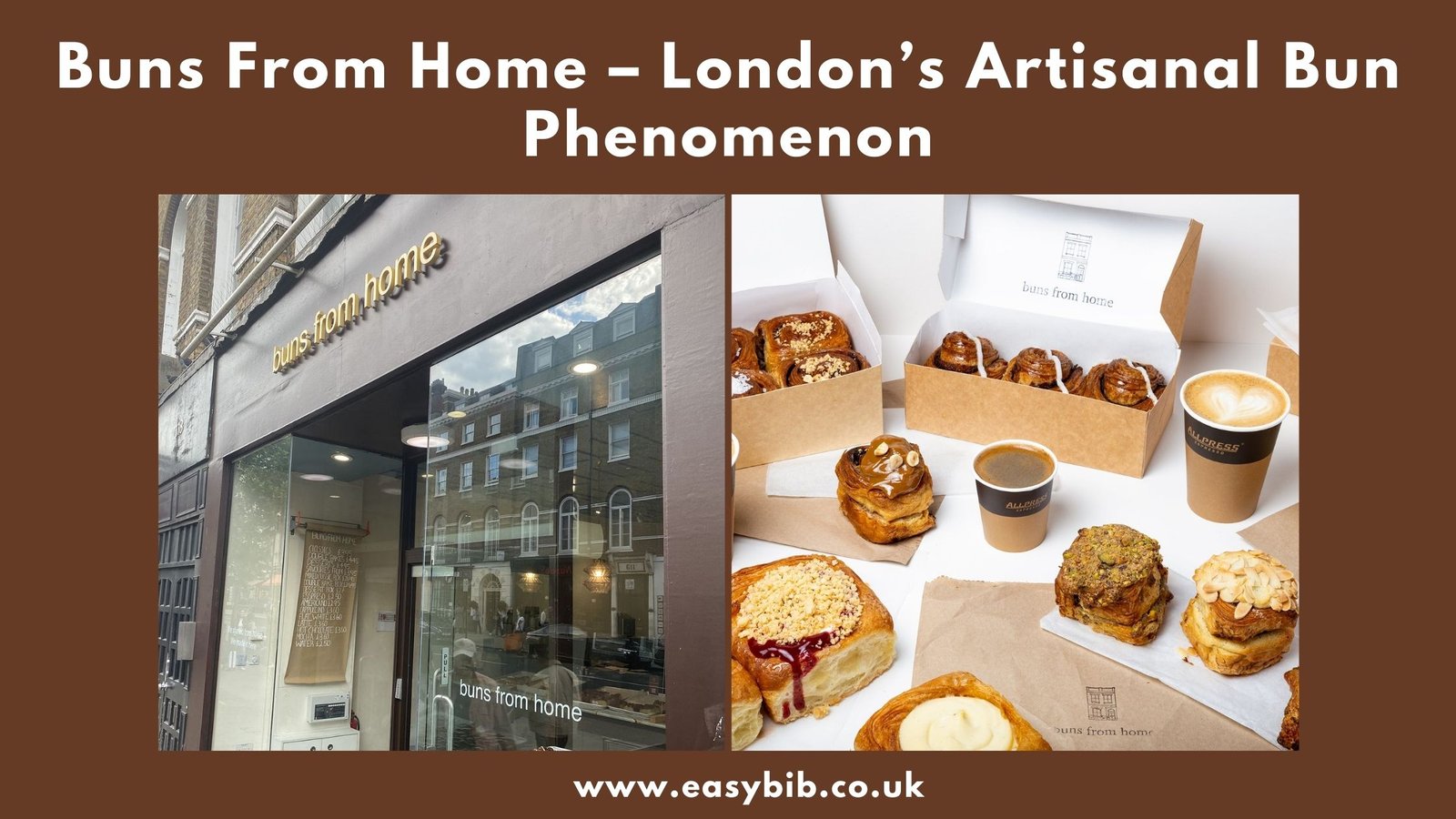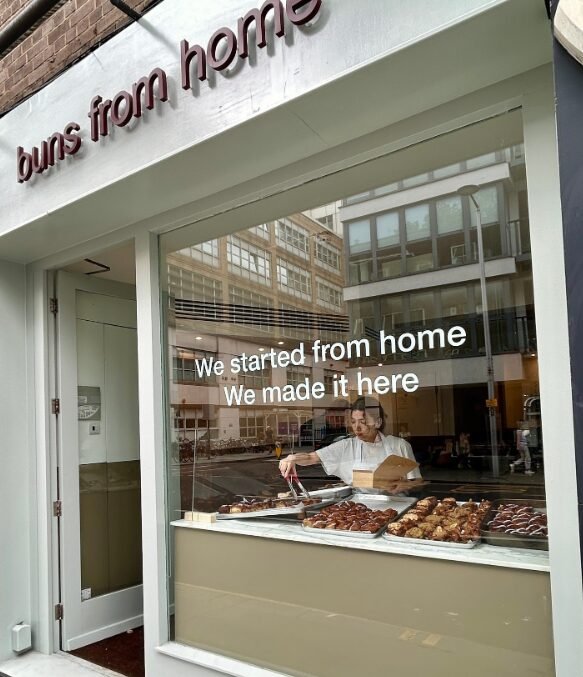Buns From Home – London’s Artisanal Bun Phenomenon

Buns From Home began as a small home baking project during the lockdown. The founder started making croissant-style buns in his mother’s kitchen. At first, he sold them to neighbours and delivered around the local area.
The concept quickly grew in popularity. People loved the buttery, flaky texture and creative flavours. Encouraged by the support, he opened the first physical store in Notting Hill. What began as a kitchen experiment soon became one of London’s favourite bakery brands.
The philosophy from the start was simple. Freshly baked buns made daily using high-quality ingredients. The dough is laminated like a croissant, creating delicate layers. Each bun is hand rolled, filled, and finished with care. The name “Buns From Home” reflects both its origin and its welcoming, homely approach.
Locations Across London
1. Notting Hill – The Original Shop
The Notting Hill location was the first permanent store for Buns From Home. It has a pastel pink awning that makes it easy to spot. The smell of fresh buns often greets customers before they step inside. This shop quickly became a favourite with locals and tourists alike. Many people stop by for a bun and coffee while exploring the neighbourhood.
2. Covent Garden – A Central Destination
The Covent Garden shop is located in The Yards, a busy area filled with shops and theatres. It attracts both shoppers and commuters. Many customers grab a bun before work or as a treat before a show. Its central location means it is almost always busy. The store keeps the same menu as the original shop but offers a more urban, fast-paced experience.
3. Other Popular Locations
Buns From Home has expanded to several other London neighbourhoods. These include Holland Park, South Kensington, Canary Wharf, Angel, and Camden Passage. Each shop has the same menu but a unique atmosphere based on its location. The Canary Wharf store is popular with office workers, while the South Kensington branch draws students and residents. The growth shows the brand’s strong following across different communities.
READ MORE
The Menu – A Mix of Classics and Specials
Buns From Home is known for its croissant-style laminated buns. These are flaky on the outside and soft inside. The most popular flavours include:
- Cinnamon Bun – Made with brown sugar and cinnamon, topped with creamy icing. Sweet, warm, and comforting.
- Chocolate & Hazelnut Bun – Filled with smooth chocolate and hazelnut paste. Rich and indulgent.
- Cardamom Bun – Spiced with cardamom for a fragrant, Scandinavian-style taste. Balanced and not overpowering.
- Pistachio Bun – Double baked with pistachio frangipane and topped with crushed pistachios. Nutty and satisfying.
Weekend Specials
Every weekend, the bakery offers a special flavour. These change regularly, keeping the menu exciting. Past specials have included cheesecake buns, lemon drizzle, salted caramel, and almond cream. Some are inspired by classic desserts, while others are more experimental. Seasonal flavours also appear during holidays, such as mince pie buns at Christmas.
Bun Boxes and Drinks
Customers can buy individual buns or boxes of 3, 6, or 12. The boxes are popular for gifts, office treats, or family gatherings. Prices vary depending on the quantity. Drinks include specialty coffee, tea, and hot chocolate. Each drink is designed to complement the sweetness of the buns.
How They Are Made?

Buns From Home places a strong focus on craftsmanship. Each bun is made from laminated dough, a process where layers of butter are folded between layers of dough. This creates the light, flaky texture that defines the brand. The dough is rolled by hand, filled with flavour, shaped, and baked fresh each day.
High-quality ingredients are key. Real butter, fresh spices, and natural flavourings are used whenever possible. The pistachio buns contain genuine pistachio paste, while the cinnamon buns use aromatic brown sugar for depth of flavour. The bakery avoids artificial tastes, keeping the flavours clean and rich.
Many of the buns are vegetarian-friendly, and some are halal-friendly. However, a few specials may contain alcohol or gelatin, so customers are encouraged to check if they have dietary restrictions.
Customer Experience
Customers often describe the buns as warm, fresh, and perfectly flaky. The combination of crisp pastry layers with soft, buttery centres is a favourite feature. The variety of flavours means there is always something new to try. Many people also enjoy the visual appeal – the buns are generously filled and beautifully decorated.
The weekend specials are especially popular. They often sell out quickly, creating a sense of excitement and exclusivity. Social media has played a big role in spreading the word, with photos of gooey buns and colourful toppings attracting food lovers across the city.
While most feedback is positive, some customers mention that certain buns can occasionally be dry, especially if left out for a while. Others point out that the busiest locations can have long queues during peak times. Seating is limited in most stores, which means many people take their buns to go. These small issues haven’t stopped the brand from growing, but they are worth noting.
Why Buns From Home Stands Out?
Buns From Home has built its reputation on doing one thing extremely well. By focusing almost entirely on buns, they have refined their technique and built a clear brand identity. The quality of the baking, combined with a rotating menu of creative flavours, keeps people coming back.
The origin story adds to the appeal. Many customers connect with the idea of a home-based project turning into a city-wide success. The brand feels approachable and personal, even as it expands.
The Role of Location in Their Success
Opening shops in high-footfall areas has helped Buns From Home grow quickly. Locations like Covent Garden and Canary Wharf ensure constant customer flow. Smaller neighbourhood shops like Notting Hill keep the brand connected to its roots. This mix of tourist, commuter, and local-focused outlets gives the business a broad customer base.
The stores themselves are designed for efficiency. They are compact, with a focus on counter service. The baking often happens on-site, so customers can smell fresh buns as they enter. This sensory experience is part of the charm.
Seasonal Trends and Social Media Buzz
Part of the excitement around Buns From Home comes from its seasonal and special flavours. These limited-time offerings encourage repeat visits and give loyal customers something to look forward to. Holiday-themed buns often appear in December and springtime, creating a festive connection.
Social media has amplified the brand’s growth. Pictures of glossy icing, melting chocolate, and vibrant toppings have made the buns a trending topic among London foodies. Influencers and bloggers regularly feature them, adding to the hype.
READ MORE
Challenges and Criticism
Like any fast-growing business, Buns From Home has faced challenges. Rapid expansion can lead to inconsistencies between locations. Some customers have experienced differences in freshness or presentation depending on the branch.
Busy central locations can also feel crowded, and queues are common at peak times. While this shows high demand, it can be frustrating for those in a hurry. Another small drawback is the lack of seating in most branches, which limits the experience to takeaway for many customers.
Final Thoughts
Buns From Home has become a beloved part of London’s bakery scene. It combines the warmth of a homegrown story with the skill of professional baking. Each bun is a small piece of indulgence, flaky, buttery, and full of flavour.
Whether you visit the original Notting Hill shop, the busy Covent Garden location, or a newer branch, the experience is the same: fresh buns made with care. The brand’s growth shows no sign of slowing down, and its place in London’s food culture seems secure.
